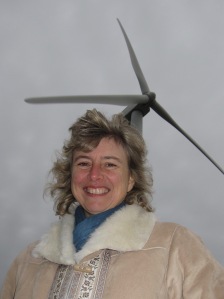by Ivy Main, cross posted from Power for the People VA

Yes, you will say I have expensive taste. But it’s not for me, it’s for the children! Picture their shining faces on Christmas morning when they find Santa has delivered 62 SiemensGamesa 8.0-megawatt, pitch-regulated, variable speed offshore wind turbines sporting a rotor diameter of 167 meters each, to a patch of ocean 27 miles east of Virginia Beach.
Or the turbines could be GE’s sleek Haliade 150-6 MW like my friends up in Rhode Island got two years ago, or the MHI Vestas 10 MW beast that the cool kids are talking about. It sports a hub height of 105 meters and has blades 80 meters long. A single one of those bad boys can power over 5,000 homes.
But really I am not particular; these are just suggestions.
I know we’re getting two turbines in 2020 as a demonstration project, and I’m grateful, I really am. But all the clued-in states are serious about offshore wind, and they’re building projects of 200 MW and up. We’ll be left behind if we don’t get in the game.
The states north of us are making port upgrades, attracting new businesses, and doing workforce training. They look at offshore wind as not just a jobs generator, but as a way to save money on energy costs, meet sustainability goals, improve the environment and reduce their reliance on fracked gas and imported energy.
They’re positioning themselves to be serious players in a huge industry that a decade from now will employ tens of thousands of Americans. In the decade after that, offshore wind turbines will start delivering power to the West Coast, Hawaii and the Great Lakes region. The effect will be transformative, as offshore wind energy feeds East Coast cities, pushes out the last of the Midwestern coal plants and leaves the fracking industry without a market.
Think that’s just the eggnog talking? Consider these indicators of an industry that’s taking off:
1. Offshore wind is now a global industry.Offshore wind got its start in Europe more than 20 years ago as a way to get more wind energy without sacrificing valuable land space. But just in the last few years, it has spread to China, South Korea, Taiwan, Japan, and Vietnam in addition to the U.S. Analysts estimate China alone will have 28,000 megawatts installed by 2027.
Offshore wind has been slow to advance in the U.S. because building 600-foot tall machines and planting them twenty-five miles out to sea is not cheap or easy, and the federal government had to devise a regulatory scheme from scratch. As the kinks get worked out and a manufacturing and supply chain emerges, the U.S. will move to the forefront of the industry. We always do.
2. Offshore wind competes on price in many markets. Offshore wind is cheaper than fossil fuels and nuclear in Europe already. That hasn’t been so true in the U.S. thanks to abundant coal and fracked gas, but even here, tumbling offshore wind prices have states looking at offshore wind as a way to help customers save money on energy. Bloomberg reported that Massachusetts’ first commercial-scale offshore wind farm will save electricity users $1.4 billion over 20 years.
3. Early movers in the U.S. are already doubling down. Massachusetts and New York, which committed to a limited number of offshore wind projects early in order to capture a piece of the jobs pie, now want more projects. New York has set a goal of 2,400 MW by 2030; this fall Governor Andrew Cuomo announced a solicitation for 800 MW. This fall New Jersey announced a solicitation for 1,100 MW of capacity, a down payment on the state’s goal of 3,500 MW by 2030.
3. Large multinational companies are buying the entrepreneurial start-ups.This year Ørsted, the energy giant formerly known as DONG Energy (for Danish Oil and Natural Gas) acquired Deepwater Wind, the scrappy developer of the Block Island project as well as projects in other states. French company EDF Renewables bought Fishermen’s Energy, another homegrown company that sought to give fishing interests a stake in wind projects.
Along with big developers have come big law firms. You know there’s going to be serious money involved when $800 an hour lawyers trawl for clients at industry conferences.
4. Oil and gas companies have moved in. Shell Oil and its partner EDP Renewables just spent $135 million for the right to develop a lease area off Massachusetts large enough to accommodate 1,600 MW of wind turbines. Norway’s Equinor (formerly Statoil) also put in $135 million for another section of the lease area, with the third piece going to a European partnership.
American oil companies haven’t shown the same level of interest yet, but their suppliers in the Gulf of Mexico are handing out cards at offshore wind conferences, advertising their offshore expertise in everything from cables to shipbuilding.
5. Offshore wind turbines have evolved away from their land-based kin. Unfettered by space limitations, offshore turbines now average close to 6 MW, more than twice the size of the typical land-based turbine. Wind farms slated for completion over the next several years will use even larger turbines, ranging in size up to a General Electric 12 MW turbine expected to deploy in 2021, and even larger ones still on the drawing boards.
Foundations are diversifying, too, away from the original “monopile” design that mimics its land-based counterparts. Floating turbines will become mainstream in the next decade, enormously increasing design options as well as potential locations for wind farms.
This will prove a special boon to the U.S., because while most of the East Coast is blessed with a shallow outer continental shelf that allows for fixed foundations even 30 miles from shore, the deep waters of the West Coast require floating technology to feed energy-hungry California. And the open ocean offers a lot of space.
So what’s holding Virginia back?
Dominion Energy holds the lease on the commercial-scale Wind Energy Area off Virginia. The company won it for a mere $1.6 million back in 2013, and not a whole lot seems to have happened with it since then. Dominion needs a customer, or perhaps just competition.
But Governor Northam is determined to see Virginia become a supply chain hub for at least the Mid-Atlantic states, and he has adopted a goal of achieving 2,000-MW of wind energy off our coast by 2030.
That means I am not the only person in Virginia who wants a wind farm in my Christmas stocking, although I am likely the only one trying to get you to picture that image.
Admittedly, even Santa could find this a tall order (ho ho ho!), but Virginia is now rife with data centers that consume huge amounts of energy, owned by corporations that have promised the energy will be clean. So far the actions of these corporate players have lagged behind their promises.
So if Santa can’t bring the governor and me a 500 MW wind farm off the coast of Virginia, maybe Amazon will deliver.
This column originally appeared in the Virginia Mercury on December 24, 2018. As this is now December 26, perhaps you think people are asking me if I got my wind farm yesterday. But no one has. Because of course they know it is out there, only waiting for us to do the hard work to make it a reality.














